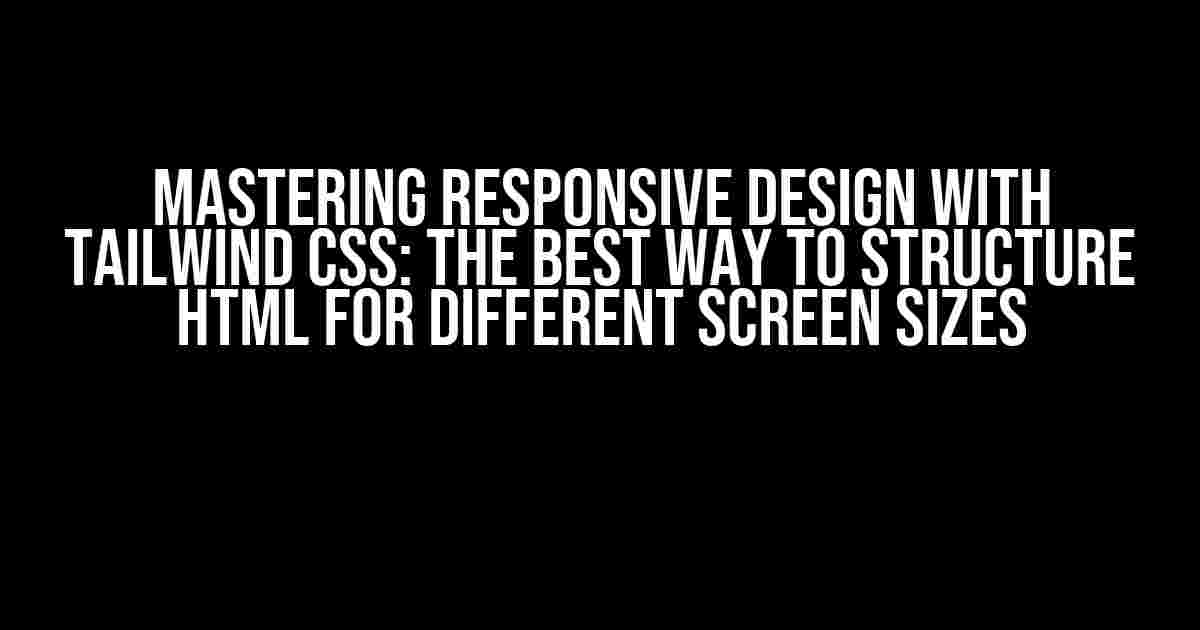As a developer, you know that building responsive designs that adapt seamlessly to different screen sizes is crucial in today’s digital landscape. With the rise of mobile devices, tablets, and various screen resolutions, creating a website that looks and functions flawlessly on all devices can be a daunting task. That’s where Tailwind CSS comes in – a utility-first CSS framework that makes responsive design a breeze. In this article, we’ll dive into the best way to structure HTML based on screen sizes using Tailwind CSS and React.
Understanding Screen Sizes and Breakpoints
Before we dive into the nitty-gritty of structuring HTML, it’s essential to understand the different screen sizes and breakpoints that we need to cater to. Here’s a breakdown of the most common screen sizes and their corresponding breakpoints:
| Screen Size | Breakpoint |
|---|---|
| Mobile (portrait) | < 576px |
| Mobile (landscape) | ≥ 576px < 768px |
| ≥ 768px < 992px | |
| Laptop | ≥ 992px < 1200px |
| Desktop | ≥ 1200px |
Configuring Tailwind CSS for Responsive Design
Out of the box, Tailwind CSS comes with a set of pre-defined breakpoints that you can use to create responsive designs. To get started, you’ll need to install Tailwind CSS and create a `tailwind.config.js` file in your project root. Here’s an example configuration:
module.exports = {
mode: 'jit',
purge: ['./pages/**/*.{js,ts,jsx,tsx}', './components/**/*.{js,ts,jsx,tsx}'],
theme: {
screens: {
sm: '640px',
md: '768px',
lg: '1024px',
xl: '1280px',
'2xl': '1536px',
},
},
variants: {},
plugins: [],
}
In this example, we’re defining five breakpoints – `sm`, `md`, `lg`, `xl`, and `2xl` – which correspond to the screen sizes mentioned earlier. You can adjust these values to fit your specific needs.
Structuring HTML for Responsive Design with Tailwind CSS
Now that we have our breakpoints configured, let’s dive into structuring our HTML to take advantage of Tailwind CSS’s responsive utility classes. Here’s an example of a basic layout:
<div class="container max-w-md mx-auto p-4 pt-6 md:p-6 lg:p-12">
<header class="flex justify-between mb-4">
<h1>Responsive Design with Tailwind CSS</h1>
<nav>
<ul>
<li><a href="#">Link 1</a></li>
<li><a href="#">Link 2</a></li>
<li><a href="#">Link 3</a></li>
</ul>
</nav>
</header>
<main>
<p>This is some sample content</p>
</main>
</div>
In this example, we’re using Tailwind CSS’s `max-w-md` utility class to set the maximum width of the container to medium size on large screens. We’re also using `mx-auto` to center the container horizontally, and `p-4` to add padding on all sides. On medium screens and above, we’re adding more padding using the `md:p-6` class. On large screens, we’re adding even more padding using the `lg:p-12` class.
Using React to Create Responsive Components
Now that we have our HTML structured, let’s create some responsive React components using Tailwind CSS. Here’s an example of a responsive navigation component:
import React from 'react';
const Nav = () => {
return (
<nav class="flex justify-between mb-4 md:flex-col lg:flex-row">
<ul>
<li><a href="#">Link 1</a></li>
<li><a href="#">Link 2</a></li>
<li><a href="#">Link 3</a></li>
</ul>
</nav>
);
};
export default Nav;
In this example, we’re using Tailwind CSS’s `flex` utility class to create a flexible navigation container. On medium screens and above, we’re using the `md:flex-col` class to stack the navigation items vertically. On large screens, we’re using the `lg:flex-row` class to display the navigation items horizontally.
Tips and Tricks for Responsive Design with Tailwind CSS
Here are some tips and tricks to keep in mind when using Tailwind CSS for responsive design:
- Use the `w-full` utility class to set the width of an element to 100% on all screens.
- Use the `md:w-1/2` utility class to set the width of an element to 50% on medium screens and above.
- Use the `xl:hidden` utility class to hide an element on extra large screens and above.
- Use the `lg:grid` utility class to create a grid layout on large screens and above.
- Use the `flex` utility class to create a flexible container that adapts to different screen sizes.
By following these tips and tricks, you can create responsive designs that adapt seamlessly to different screen sizes using Tailwind CSS and React.
Conclusion
In this article, we’ve covered the best way to structure HTML based on screen sizes using Tailwind CSS and React. By configuring Tailwind CSS to use pre-defined breakpoints, structuring our HTML to take advantage of responsive utility classes, and creating responsive React components, we can create designs that adapt flawlessly to different screen sizes. Remember to keep it simple, use utility classes wisely, and test your design on different devices and screen sizes to ensure a seamless user experience.
With Tailwind CSS and React, you can create responsive designs that are both visually appealing and functional. By following the guidelines outlined in this article, you’ll be well on your way to mastering responsive design and creating amazing user experiences for your users.
Here is the Q&A about “Tailwind – React – Best way to structure HTML based on screen sizes” with a creative voice and tone:
Frequently Asked Question
Get answers to your burning questions about structuring HTML based on screen sizes with Tailwind and React!
What’s the best way to structure my HTML for responsive design with Tailwind?
Tailwind’s utility-first approach makes it easy to write responsive HTML. Use Tailwind’s pre-defined classes like `sm`, `md`, `lg`, and `xl` to target specific screen sizes. For example, `
How do I handle different screen orientations with Tailwind?
Tailwind’s got you covered! Use the `portrait` and `landscape` classes to target specific orientations. For example, `
Can I use CSS media queries with Tailwind?
While Tailwind provides pre-defined classes for common screen sizes, you can still use CSS media queries to target specific use cases. In fact, Tailwind’s utility-first approach encourages a hybrid approach, where you use utility classes for most cases and fallback to media queries for edge cases. For example, you can write `@media (max-width: 768px) { /* custom styles */ }` to target specific styles for screens below 768px.
How do I handle responsive images with Tailwind and React?
Use Tailwind’s `w-full` or `h-full` classes to make images scale responsively. For example, ` ` will make the image take up the full width and height of its container, while maintaining its aspect ratio.
` will make the image take up the full width and height of its container, while maintaining its aspect ratio.
What’s the best way to organize my React components for responsive design?
Organize your React components based on their functional roles, rather than their responsive behavior. This keeps your components reusable and modular. Use Tailwind’s utility-first approach to add responsive classes to your components as needed. For example, you can have a `Header` component that uses `md:flex` to become a flex container on medium screens.



